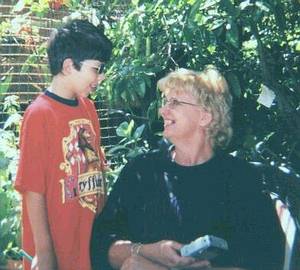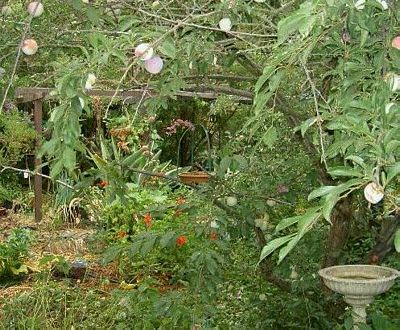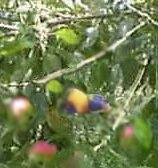The Garden of Lidy and Yvonne
Christmas Day 2003
 Probably sharing computer tips, Lidy and Alex are chatting happily in the garden that she and Yvonne created. This beautiful garden was once a “front lawn”. Grass lawns are not suitable for Australia, as this year's drought has shown; the fragile English grasses need more water than can reasonably be spared.
Probably sharing computer tips, Lidy and Alex are chatting happily in the garden that she and Yvonne created. This beautiful garden was once a “front lawn”. Grass lawns are not suitable for Australia, as this year's drought has shown; the fragile English grasses need more water than can reasonably be spared.
Leaving all of the existing trees just as they were, the two women set to work piling compost many inches thick over the depleted soil. Dozens of new plants went in, both annual and perennial: roses and passionfruit and a fig tree, an avocado, globe artichokes and grape vines. Lidy built a rose arch. Yvonne established vegetables.
Together they made an arbour where one can sit on a stifling day and watch thornbills and silver-eyes refreshing themselves in the water bowls that hang half hidden in the trees. Brilliant zygo cacti hang from the outside of this arbour, rubbing shoulders with baskets of petunias and verbena.
On the north side of this little paradise is a run for five fat chooks, the wire confining them partly concealed by flourishing raspberry canes.
At the back of the house a pergola supports long-established grape vines, and every evening at dusk a ring-tailed possum climbs from his day-time residence in a clump of bamboo out onto the vines to feast on the fruit or to clamber into adjoining trees and nibble flowers.
Larger birds—mainly exotics like blackbirds and doves—use the large, pedestal type baths such as that seen in the bottom right of this picture, while the “little brown jobs,” as tiny native birds are affectionately known, prefer shallow water in a dish placed high above the ground.
 Some of the little natives, especially silver-eyes, arrive in big flocks, searching for and finding numerous insects that would otherwise damage trees and fruit. They’re never still; they hop from a branch to the water bowl, splash busily and hop back into the trees for more hunting, so that a tree full of them seems almost to vibrate.
Some of the little natives, especially silver-eyes, arrive in big flocks, searching for and finding numerous insects that would otherwise damage trees and fruit. They’re never still; they hop from a branch to the water bowl, splash busily and hop back into the trees for more hunting, so that a tree full of them seems almost to vibrate.
Lidy’s rose arch can just be glimpsed in the centre-back of the picture. This was taken during a time of trying heat and dryness, so that the garden is by no means at its best.
Lidy is a skilful photographer and has taken lovely close-up shots of flowers from this garden. She is presently preparing a selection to publish on the web. I'm rather hoping that she'll find me a couple of shots of the several varieties of parrots that also enjoy the fruit and the coolness provided here. Unfortunately, cheeky though they are, the parrots try to avoid being photographed.
 You'll find it hard to make out, but amongst the leaves there’s somebody reaching out to take a bite from an apple.
You'll find it hard to make out, but amongst the leaves there’s somebody reaching out to take a bite from an apple.
Even getting close enough to take as indistinct a picture as this is quite a challenge; obviously the thief wants there to be no recorded evidence!
This is a rainbow lorikeet, officially a nectar-eating forest bird, but flocks of them travel into outer suburbs of eastern Australian cities to feast on fruit and blossom. Occasionally they cause destruction in orchards, too.
Their arrival is often announced by noisy screeching. Once settled in a tree, though, while they may chatter, they more often feed quietly and it can be quite a surprise to walk into the garden and see four or five pairs fly off.
Yvonne
Yvonne seems to have a fear that people and animals will slowly starve to death unless she feeds them often and generously. She’s always willing to try out new and interesting fruits, vegetables and recipes, although she has a solid mental library of old favourites, particularly sour-dough breads. Here she is putting lunch together for family members.
.
Choose another picture or go to the top of the page.
Questions or comments? I’d love to hear from you. My email address is here.
Return to top
22 April 2003





















